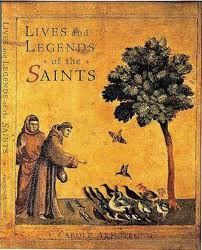I stumbled across this book whilst browsing the shelves of my local library, helping my son to research an assignment. Given my recent brush with
St Roch I was immediately intrigued. I flicked through, noticed that Joan of Arc was there- and I was hooked. Naturally it came home with me.
I'll be the first to admit that my religious knowledge is almost non-existant. So I learnt lots from this simple but beautiful book.
20 saints are featured. Some big names of course. Joan, naturally. John the Baptist. Luke. Paul. Peter. Michael. George. But also many lesser known saints for me. Apollonia. Lucy. Eustace. Martin of Tours. All illustrated by a beautiful old paintings, some by very well known Masters- Giotto, on the cover with Saint Francis of Assisi, Hieronymous Bosch, Raphael and Caravaggio.
Whilst I enjoyed all the saints featured, I found the women the most interesting, and somehow their paintings were the most appealing too.
Saint Lucy was a wealthy Sicilian noblewoman in the 3rd century, who apparently tore out her own eyes to send to a suitor. He became a Christian inspired by her courage and devotion, and her eyes and sight were then restored. While I can suspend disbelief for a while, it would be fascinating to know the basis of this story.
The painting of her by Francesco del Cossa, currently
on display at the National Gallery of Art in Washington, has her holding a pair of eyes on a handle, and a palm leaf, the symbol of triumph over death. I love the beautiful golden background and think that this must be astonishing to see in real life.
Catherine of Alexandria, sadly now most famous for her mode of torture (the Catherine Wheel), lived in Alexandria in the 4th century. She publicly protested the persecution of Christians, but it was her refusal to marry the emporer Maxentius that caused her to be tortured on the spiked wheel. Angels threw bolts of lightening so the wheel broke, and she was eventually beheaded, where milk flowed from her neck, rather than blood. The stories of the saints are so often gruesome, as is much of history I suppose, but none of that is conveyed in the rather serene portrait of her by Fernando Yanez de la Almedina.

She is standing astride the broken wheel that was used to torture her, and depicted with a book of philosophy (presumably because she had converted the 50 famous philosophers Maxentius sent to sway her from Christianity. I wonder if we would find 50 famous philosophers these days. Perhaps the ancient world had more philosophers than we do now), a crown symbolising her royalty and the palm leaf of martyrdom (a big motif in painting the saints genre).
The story of Apollonia is particularly extraordinary. She was an elderly deaconess living in Alexandria. In 249 AD the Roman emporer Decius was persecuting Christians. A mob formed, many Christians fled, but Apollonia stayed to comfort them. She was arrested by the authorities and ordered to "worship their stone idols". Apollonia refused, and made the sign of the Cross, which caused the statues to break. As her punishment all her teeth were pulled out one by one. She was then threatened with being thrown onto a bonfire unless she renounced her faith. She stalled by saying she needed time to think. She chose to jump on the fire rather than be thrown.
Apollonia is typically portrayed as a young girl despite having been an old woman at the time of her death. She is always shown wearing a necklace of teeth or holding a single tooth in a pair of pincers as in this portrait by Francisco de Zurbaran, a portrait that I shall have to seek out on my next visit to the Louvre.
Saint Cecilia also lived in the 3rd century, in Rome. Cecilia was a Christian who converted her husband and brother in law to Christianity on her wedding day. The Governor of Rome killed the two men and ordered Cecilia to worship Rome's pagan gods. She was sentenced to death by suffocation for her refusal, but survived. She was then to be beheaded with a sword. Cecilia survived for three days, allowing her to give away all her money to the poor before she died.
Cecilia was so close to heaven that she could hear the angels singing. She invented the organ, which came to represent harmony and praise for God. She became the patron saint of musicians, poets and singers in the 16th century. The painting of her by Pietro de Cortona shows Cecilia wearing a crown of fresh flowers to indicate her purity, and is of course holding the ever present palm leaf of martyrdom.
And Joan? I'd seen the portrait of her by Jean-Auguste Dominique Ingres before. It's
a famous image, again housed in the Louvre. I've probably even seen it. Her basic story is presented but I didn't learn anything new in the one page summary. Overall it's a fascinating book on many levels, and I'm keen to look at some other books the library has on the lives of saints.


























